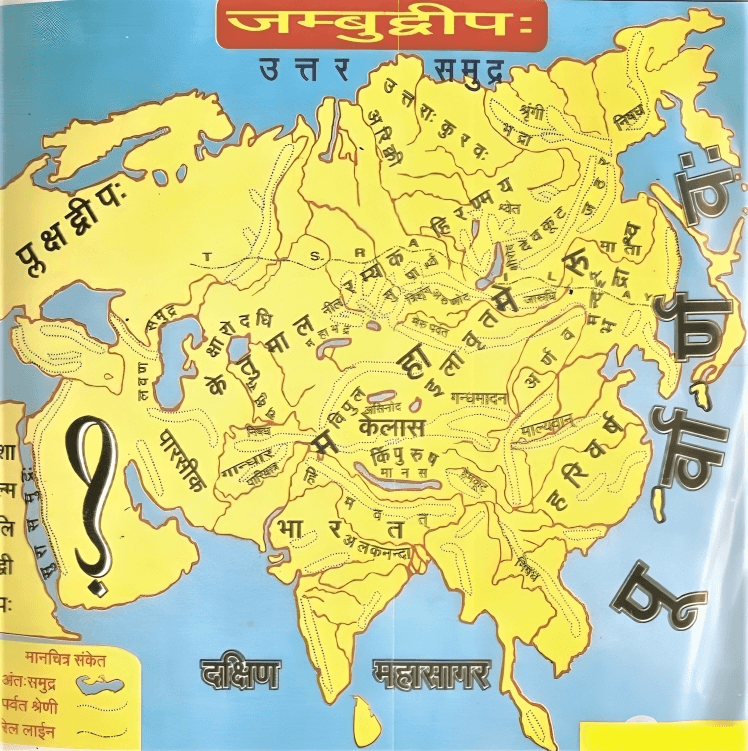Jambu Dvipa Parva or Jambu Khanda Vinirmana Parva is the sixty first Upa parva included in the sixth Maha parva named as Bhishma Parva. Vaishampayana continued narration to Janamejaya in reply to his queries. Janamejaya was very curious about the happenings in the war. He asked Vaishampayana how Kaurava and Pandava army soldiers had faced the battle.
The India sub-continent then called as Bharata Varsha or Jambu peninsular was the main area from where the kings and soldiers came marching and they had formed tents on the Western side of Kurukshetra facing the East. Yudhishtira had ordered to arrange several thousands of army camps. Duryodhana had also arranged several thousands of army camps on the Eastern side outside his palace facing the West.

Yudhishtira had distributed code words to soldiers to recognize them in the field. He also arranged sufficient food and essential items for all his warriors. Duryodhana had distributed jewels to his own soldiers to recognize them in the field. He also arranged for all, sufficient dress and other essential items. He encouraged them to fight and instructed to kill the Pandavas. Pandavas’ side and Kauravas’ side commanders formed their own terms and conditions for avoiding killing of own side soldiers due to mistaken identities.
Vyasa Rishi visited there. Vyasa was a far sighted Rishi. He visited Dritarashtra and secretly informed him about the military developments in Kurukshetra. He also informed about the bad omens and guessed about the bad results of war near his palace. Vyasa offered Dritarashtra to provide him visual ability to see the war proceedings of his children. Dritarashtra replied to Vyasa not to offer him the power of vision since the war would happen between the children grown up by him in his own palace. But as an emperor he should collect the daily news related to his palace and surroundings.
Hence Vyasa provided the visual capacity to see the war to Sanjaya. It was a holy vision. Sanjaya could read the minds of any Kurukshetra warrior containing anything and everything related to war. Sanjaya was not actually accompanied then and there, but he was able to visualise the ongoing incidences in Kurukshetra. Vyasa had elaborated the omens in his premises and instructed Dritarashtra to be cautious about the forthcoming war. Then Dritarashtra asked Vyasa about the later status of his children after war. So Vyasa had entrusted the news (media) reporting task to Sanjaya. Vyasa only hinted but not had disclosed the later stages of Duryodhana or Dushasana. Due to a heavy flood later, the palace was destroyed, so Janamejaya was sitting in Takshashila Palace then to hear this.
What Vyasa secretly told to Dritarashtra before leaving him?
Veda Vyasa Rishi knew past, current and future things. He secretly told to Dritarashtra about the war between his children including the various kings and their armies gathering in Kurukshetra outside his palace. Vyasa had left the palace but not said about the war, being free to collect details from Sanjaya.
What happened after Vyasa left from Hastinavati?
Dritarashtra had become very curious but felt sad and requested with Sanjaya to report about the war. Sanjaya started to tell about the war in detail. But then Vyasa had left the place and Dritarashtra had several doubts since he was blind. Dritarashtra had requested Sanjaya to explain the properties of land and the cause of fighting of various kings for the sake of land. Then Sanjaya had started to describe the basic properties of land of this world.
What were the properties of land symbolised by Gayatri?
Sanjaya told in general the properties of the land that was symbolised by Gayatri. Out of the five fundamental items called as Panchabhutas, Earth was very stable and basic to all. There were eight domestic animals including human beings. There were eight forest animals. There were seven types of plants and trees. In total, adding all these, the main category falls into twenty four. Lives take birth on this earth, grow and die on this earth. Hence earth would be an everlasting for all in all.
What were Panchabhutas?
Air, fire, water, sky and earth were the Panchabhutas.
What about the Sudarshana Island?
Sudarshana Island had been recognized by some different names in later periods. After Mahabharata, war many Islands were renamed and new kings had been posted there by Yudhishtira. Other than Jambu dvipa, descriptions have been separately done in Bhumi Parva in detail. Oceans, Sun and Moon were also described.
What were the rivers and mountains?
Ganga and Yamuna had been described with many other rivers. Himalaya and Vindhya mountains had been described with many other mountain series.
Which county is liked by most of these kings?
अन्येषां च महाराज क्षत्रियाणां बलीयसां ।
सर्वेषामेव राजेन्द्र प्रियं भारत भारतं ॥
Meaning: O King, there were various other kings in this world, very energetic and all of them desired the land of India as the favourite one.
Since in India the life was most comfortable, people desired to get some piece of land in India. Defence system was strong in India but everybody moved legally.
Except children and old people, almost all soldiers attended from the Jambu Dvipa. The Jambu dvipa was a vast area comprising India sub-continent. The Kuru emperor was not only responsible from Persia to Cambodia, but also looking after the entire world. It had many free countries but for the war, they joined with either one of the sides. On each side, they had formed their own rules of war.
Next post, Mahabharat: Bhumi Parva would be more interesting.
Mahabharat: Bhagavad Gita Parva would be presented separately in another article.
On reading this story, children would gain more memory power, great moral strength in their future life; create a sense of self-reliance leading to peace and progress.
It is humbly prayed for the blessings of God Krishna upon us.
Readers may share this story with children, friends and family.

0 Comments
1 Pingback